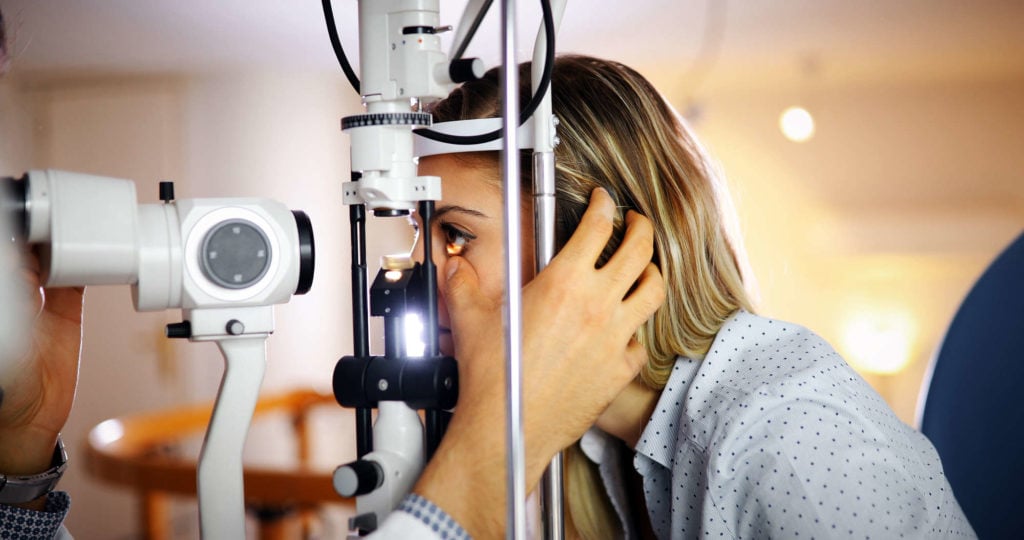

When cataract or refractive lens exchange surgery is performed, in order to achieve the ideal optical result, the new lens implant is placed within the membrane, or capsule, which held your original natural, crystalline lens.
A circular aperture is created in the front of the capsule and the new lens inserted into that space. Modern lenses are designed to stick to the capsule which embryologically grew the lens in utero.
Even though the lens has now been removed, the capsule still produces lens cells and if these grow past the square edges of the lens implant they will coat the capsule behind the lens and reduce vision, much like the symptoms of early cataract.
This process is called posterior capsule opacification (PCO) and the likelihood of occurrence varies between eyes and lens types, overall, between 2 – 20% of capsules will opacify.
The treatment for PCO is YAG laser posterior capsulotomy (YAG PC). YAG stands for the medium in which laser light is created (Yttrium Aluminum Garnett).
It is a non-invasive, quick, safe, outpatient procedure and can be performed on both eyes at the same sitting if required.

Your visit to the outpatient department will last around 30 mins. We will dilate your pupil using drops. An anesthetic drop will numb your eye and a small contact lens may be placed on the surface of the eye so that you do not need to worry about blinking. You will hear the laser make a quiet sound with each pulse, the procedure typically taking a few minutes. We will provide you with a short course of drops to use afterwards.
Immediately, there are no restrictions on activities but you will be asked not to drive immediately after your appointment as your pupil will be dilated.
Risks are very low as the procedure is non-invasive. You may see small dots or floaters immediately after treatment but your eye should be comfortable and vision clearer within a few hours. The following risks have been reported but are rare: macular oedema or swelling, damage to the lens implant or retinal tear.
YAG laser iridotomy (YAG PI) is a laser treatment to prevent angle closure glaucoma in eyes that are at risk from it.
YAG PI is a safe, non-invasive outpatient procedure and one eye at a time, or both eyes can be treated at the same sitting.
Immediately, there are no restrictions on activities but you will be asked not to drive immediately after your appointment as your pupil will be dilated.
Selective laser trabeculoplasty (SLT) is a treatment to lower the pressure in your eye if you have ocular hypertension or open angle glaucoma. The laser treatment helps fluid to drain from the eye, which in turn lowers the pressure.
Some people respond better to the treatment than others. While the initial treatment may be successful, the pressure can rise again. If this happens the treatment can be repeated, but the results may not be as good as you experienced after the first treatment. You might need to continue with eye drop treatment as well and we may recommend other treatments including surgery if we’re not happy with the pressure.
You will be given drops to make your pupil smaller and drops to numb the surface of your eye. David Anderson will then place a special contact lens onto your eye and aim the laser at the part of the eye where the fluid drains (known as the ‘trabecular meshwork’ in the angle between the iris and the cornea). Around 100 laser spots are then made to the trabecular meshwork, most patients don’t feel the treatment, but those that do usually describe the discomfort as mild. It takes about five minutes to treat one eye.
Your eyes will temporarily be dazzled by the treatment but your vision should improve in the next few hours. It may help to wear sunglasses to go home.
There is a chance you may get a headache during the first few hours, in which case you should take your usual painkiller. You may also need extra drops for a week or so after the treatment and we’ll advise you to continue with your usual glaucoma drops until your follow-up appointment.
Argon laser trabeculoplasty (ALT) is also a procedure designed to lower the pressure inside the eye if you have ocular hypertension or glaucoma. ALT has largely been superseded by SLT – see above and we no longer offer this treatment.
Nuffield Health Wessex Hospital
Winchester Road, Chandlers Ford
Eastleigh, Hampshire
SO53 2DW
Southampton | Hampshire | Surrey | Jersey | Chandler's Ford | Eastleigh
© Anderson Eye Care 2024. All Rights Reserved. Made by Digital Roo.
Enter your details below to get instant access to your free laser eye surgery infopack.